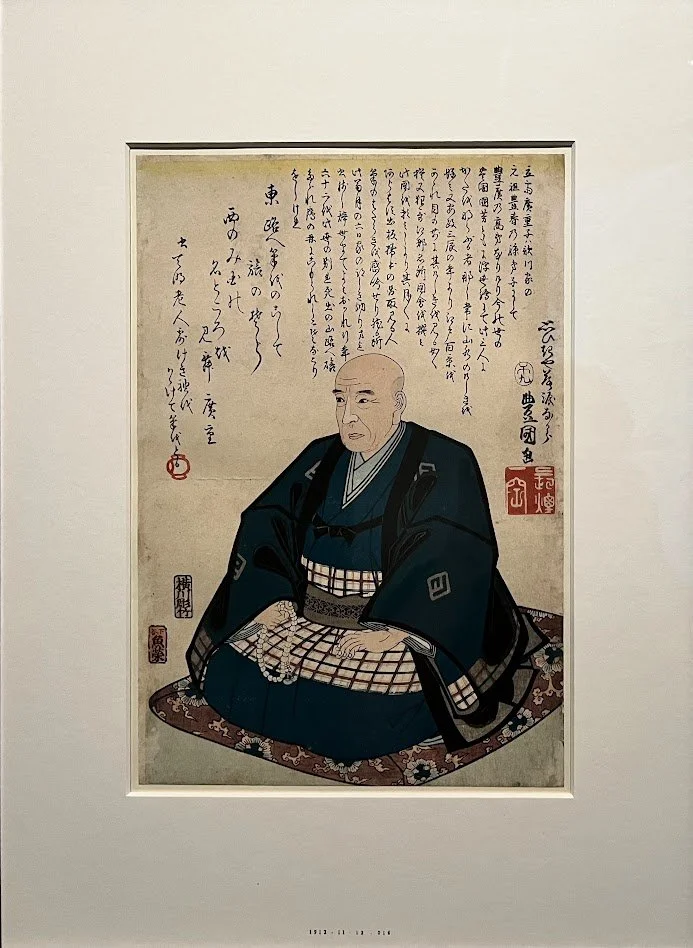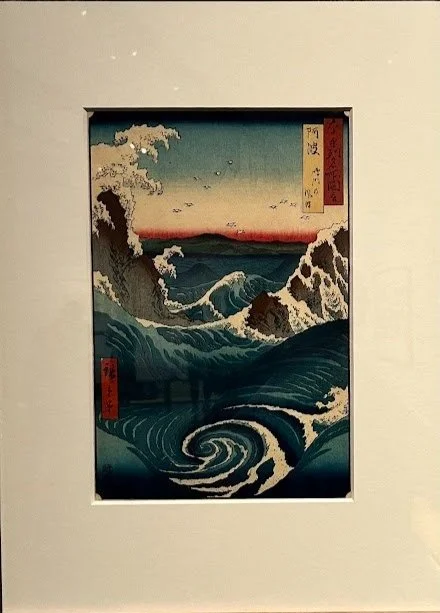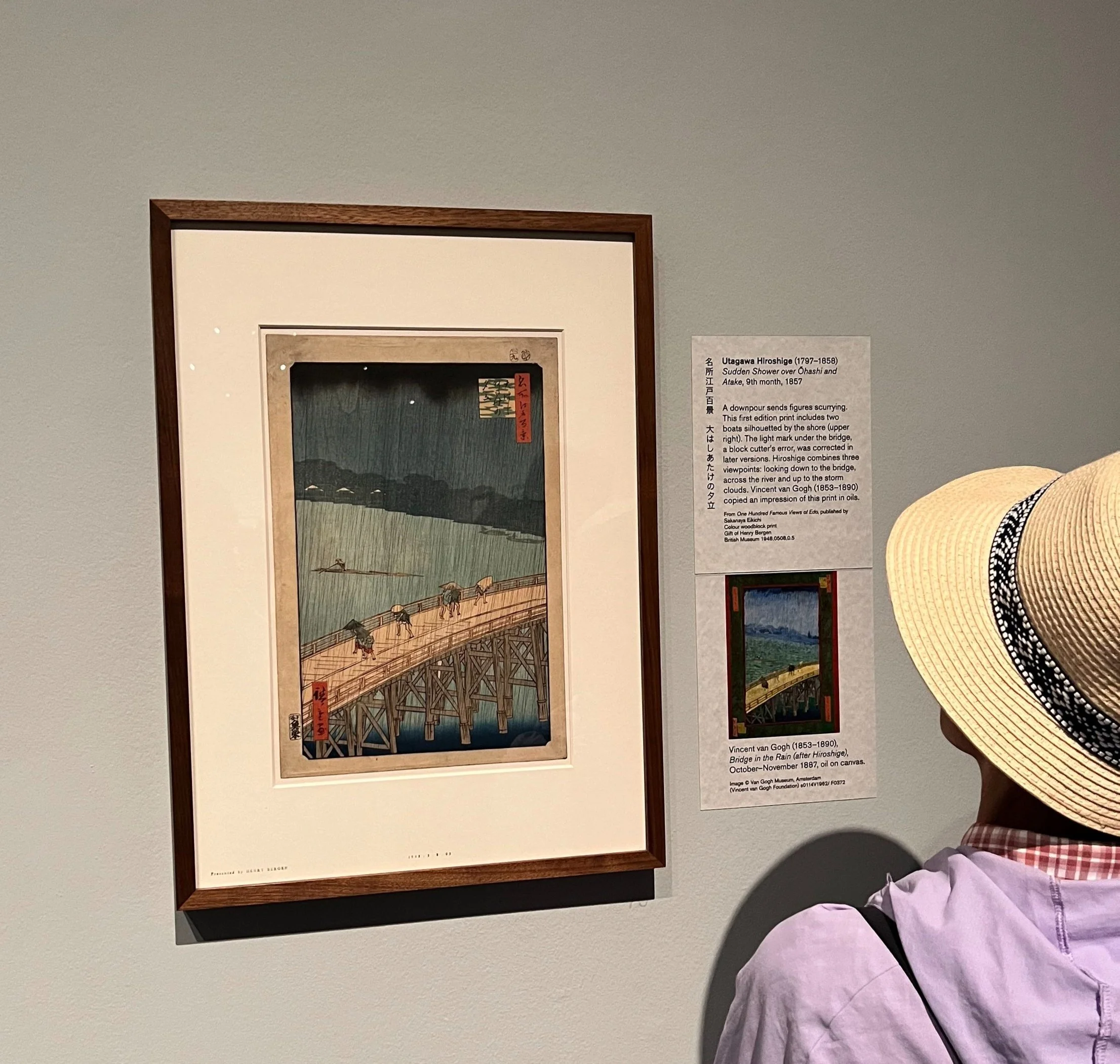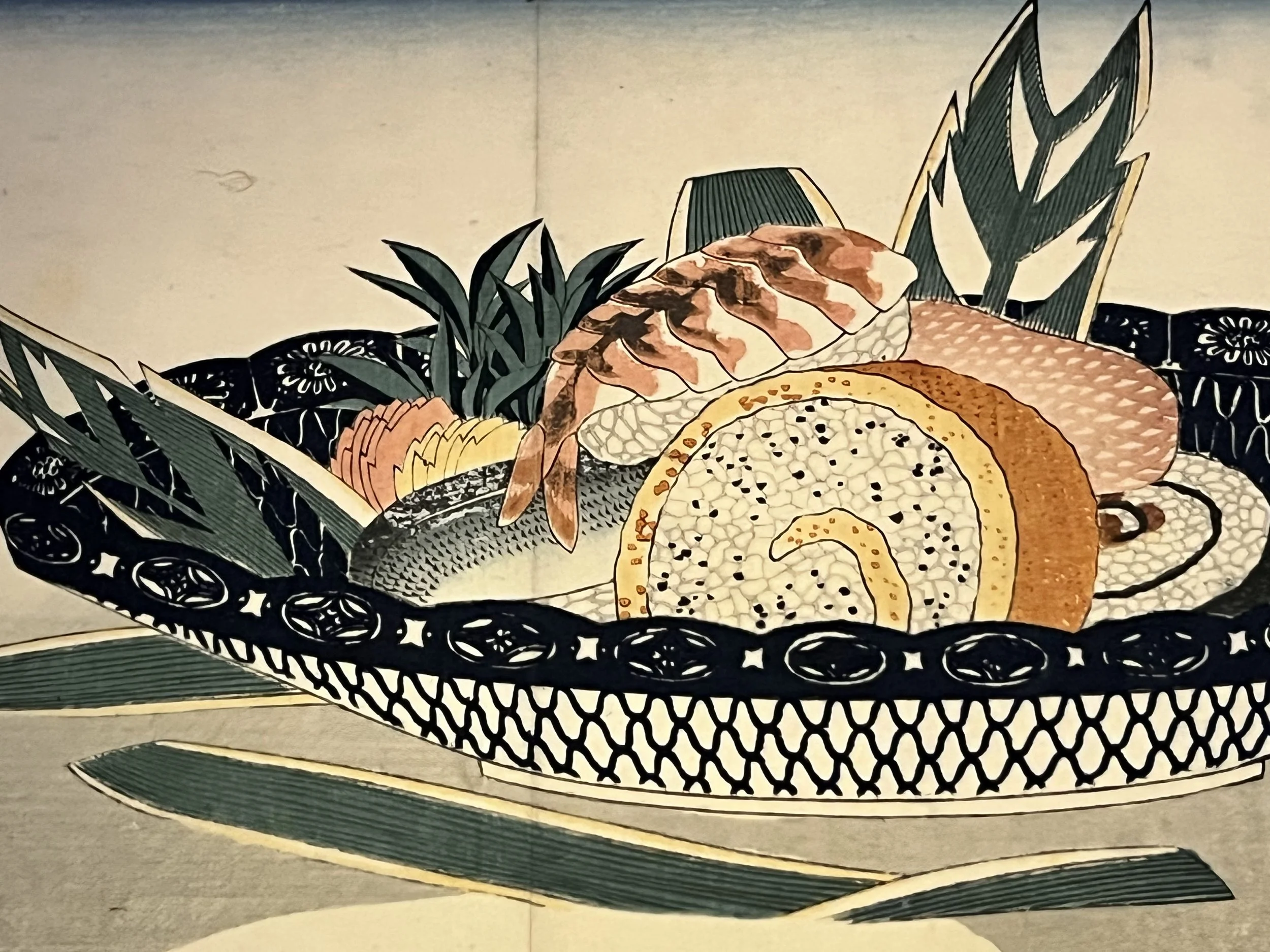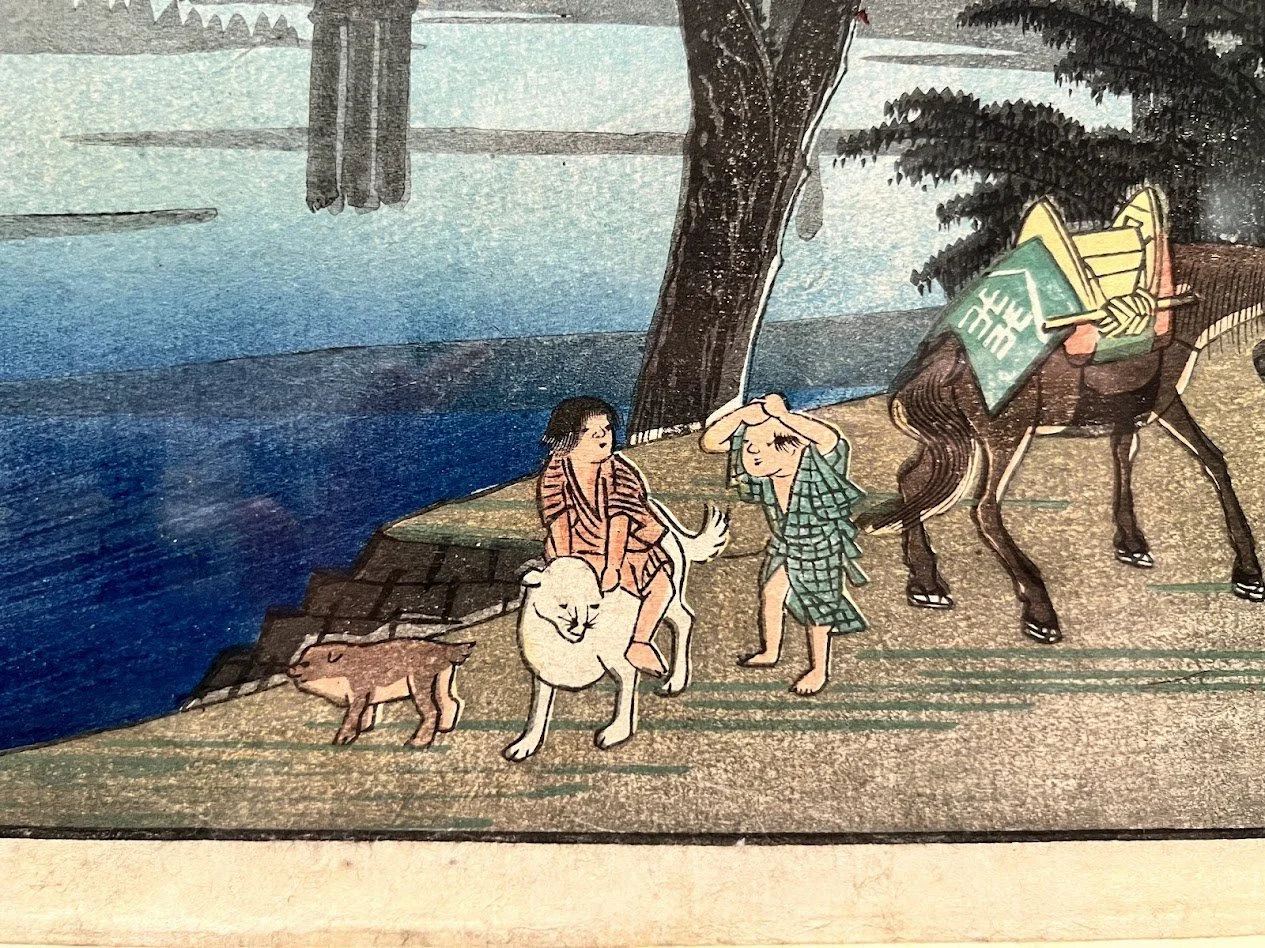Hiroshige exhibition at the British Museum- a review
My Rating:
★★★★★
”An exciting, awe-inspiring collection celebrating a master of printmaking, and showcasing the beauties of Japan’s famously sublime landscapes.”
Sunday 27th July, 2025
The British Museum is arguably the most busiest, crowded location in the whole of London, even for ticketed events. Going on a Sunday morning before the rest of the city wakes was my hope, however the queues were already stretching the length of one side of the gates by 9:45. Alas, after 10 minutes of security and the advantage of a pre-booked ticket, I was inside in time for my slot at 10:15.
Views inside the British Museum, shortly after opening- not too bad for a weekend, all things considered.This is the first exhibition of Utagawa Hiroshige’s work at The British Museum. An employee informs us that it is the largest culmination of his work, from collections of both the museum and of private lenders. After spending well over an hour inside, I can confirm that there is plenty to see.
utagawa hiroshige (1797-1858)
Born in Japan in 1797, the artist travelled all over his country and documented the landscape and cultures in relief print form. The exhibition walks you through the breadth of his career, showcasing his depictions of city life, landscapes and fauna. They’re tranquil and cinematic, colourful and joyful.
Utagawa Kunisada (approx. 1858) 'Memorial portrait of Utagawa Hiroshige'. Colour woodblock print, published by Sakanaya Eikichi
When you first walk through the dimly-lit foyer and into the space, you are greeted by the peaceful sounds of twittering birds and trickling water, and the first piece you come across is an animated, collaged slideshow of his works; waves, birds and flags are brought to life as they flutter and flow within the scenes at a relaxing pace, which perfectly sets the vibe of the whole exhibition.
Animated slideshow of Hiroshige’s prints. Animator/ editor unknown.bringing a slice of japanese history to london
Oftentimes when exhibitions of foreign artists are presented in English-speaking places, the dialogues within the space are solely in English, which I personally think detracts from the identity of the figure, but also limits accessibility. Therefore, I was impressed at the inclusion of Japanese captions alongside their English translations. There was one quote that stood out to me particularly:
“The mountains of Kai Province stretch into the distance […] the magnificent views changing every ten or twenty paces- beyond words to describe, beyond my poor brush to capture”
I was quite moved by this quote, and as an illustrator myself with a bit of a Romantic streak inside of me, I related to Hiroshige’s point of being unable to translate such sublimity into pictures or words. The same goes for those intangible emotions, too- some things you just have to experience for yourself; they can’t be articulated.
Inspired by the beauty of the natural world
As the exhibition title suggests, most prints on display are from the artist’s travels around Japan which, at the time, had begun to grow in popularity again for domestic explorers (although it was still banned for foreign travellers since the 1630s). The exhibition does well in providing historical contexts like this alongside the pieces in digestible chunks, which adds a lot of enrichment to the experience.
A close-up example of Hiroshige’s 1855 'Yui: Satta Peak and Oyashirazu'- part of his ‘Vertical (or upright) Tōkaidō’ series, marking his transition from horizontal to vertical format.Hiroshige demonstrating his skills in showing the power and force of nature in this 1855 print 'Awa: The Rough Seas of Naruto'.Influence on the western art world
As one progresses through the exhibition, it becomes apparent just how admired Hiroshige was (and still is), particularly the Impressionists, like van Gogh. It made me wonder just when did Japanese woodblock prints make their way into the Western world (note to self- research this later).
A fellow exhibition-goer observing the elements that van Gogh took from Hiroshige’s 1857 piece ‘Sudden Shower over Ōhashi and Atake, 9th month’, which inspired his 1887 oil painting transcription ‘Bridge in the Rain (after Hiroshige)’.a versatile artist exploring different subjects
There are collections of his fan works, postcards, landscape serials and fauna, with informative videos demonstrating the techniques of Japanese woodblock. I’ve tried the craft briefly myself, albeit very clumsily compared to the practitioners here. It struck me that this exhibition not only celebrates Hiroshige’s work, but also draws connections to the other craftspeople who contributed to the artwork, but whose names have largely been forgotten over time (such as the printers). It is a tedious, meticulous craft, and these prints show the complexity and beauty that can be achieved in a two-dimensional medium.
Utagawa Hiroshige (late 1830s) ‘Sushi Assortments’. Colour woodblock fan print.what are the people’s stories?
What I love most about Hiroshige is how playful he was in his art, depicting scenes of varying drama but rarely showing the turmoil of the period. I can imagine how refreshing this must have been for his audience at the time, creating optimism as opposed to adding to the problems they faced in the era.
As someone who works with narratives in my work, inspired by the little and overlooked moments of daily life, I was unsurprisingly awestruck by the way he brought his characters to life. Despite the limitations of such a notoriously finicky medium to achieve fine details in, Hiroshige was a master of body language and facial expressions at such a minute scale. Below are some close-ups of such little scenes which I particularly enjoyed:
Utagawa Hiroshige (late 1830s) ‘Nagakubo’, depicting local lads playing with their dogs, whilst behind them a packhorse is being lead to rest in its stable.Utagawa Hiroshige (late 1830s) ‘Tarui’. This was from Hiroshige’s sketching trip along the Kisokaidō. Here, a samurai lord has arrived at the station and is braving the rain, which in itself is expertly illustrated. Meanwhile, his entourage can be seen in the background whilst a local vendor observes the man.
look closely or you’ll miss it!
A common theme in Hiroshige's scenes that contain people are their intricately detailed clothing. It forces you to stop and look closely. But then you’ll spot something else, like the subtle impression of a lone figure in the background or a mischievous-looking youth in a crowd. Before you know it, 5 minutes have gone by and you’re officially hooked.
Here in Hiroshige's 'Karuizawa' (late 1930s), he cleverly uses light to direct the eye to the trader's face, but also reveals the details of his clothes. Every person is experiencing their own unique life
Take a look at the designs on the kimonos in the next piece, but also the delicate features of the women compared to the harder lines on the man. What are they all thinking?
Utagawa Hiroshige (1832-4) 'Pleasure Boats at Ryōgoku in the Eastern Capital'
And these ones- see the attention to detail Hiroshige has paid to what each character is doing.
Utagawa Hiroshige (1834) ‘Autumn Maples at Tsüten BridgeUtugawa Hiroshige (1834) Enjoying the Evening Cool along the Shijō Riverbedthe art of illusions
Hiroshige also proves the theory of ‘less is more’ when illustrating people’s faces- if they even have one at all. They are impressions- suggestions rather- but are more than enough to engage one’s imagination. His people truly feel alive.
Utagawa Hiroshige (1834) 'Enjoying the Evening Cool along the Shijō Riverbed'. Depicting how locals made use of the dried-up Kamo River as a space for socialising in the summer.paving the way for wider arts accessibility
A benefit of this medium was the ability to print many copies at a reasonable price which, like the printing practice over in the Western world at the same time as Hiroshige in Japan, made the artwork accessible for more people. Compared to the expensive, time consuming nature of oil paintings which were most popular at the time, this breakthrough opened the doors to the poorer people of society who were previously excluded from the arts- now they could bring a slice into their own homes.
A display showing how his prints were converted to other products.FANS
Another area that he ventured into was the production of fans. Novel but practical, Hiroshige’s designs would be applied to the fans and again, purchased by many who would use them to keep cool in the hot Japanese weather, before disposing of them at the end of the season. And thus the cycle continued, whilst simultaneously exposing more and more people to the artist’s work.
Utagawa Hiroshige (1854) ‘The Crossing at Nii Station’. A winter scene for a summer fan- cool!Final thoughts on the exhibition itself
Hiroshige’s sketchbook, late 1830s.Situated inside the curious cylindrical tower at the centre of the domed museum labyrinth- on the second floor- the exhibition had enough to keep me engaged for well over an hour. There are also lifts, so it is accessible in every possible way. The space is busy, but acceptable- my only complaint would be that there is only one bench in the whole exhibition, which isn’t great for people who can’t stand for long periods of time.
While I could include and analyse a gazillion photos here of Hiroshige’s work, I think it is best- and only fair- that you go to see for yourself if you are able to, as it just isn’t the same through a grainy smartphone pic on a screen. If you do visit, do let me know what you think in the comments below!
Take care,
E.
Please note: all photographs were taken by me with the permission of museum staff. All views shared are my own, and unaffiliated with The British Museum- this is simply an amateur review for fun, non-commercial purposes. Please see their exhibition website for more information and to book tickets.Hiroshige: artist of the open road.
1st May-7th September 2025
The British Museum, Great Russell St, London WC1B 3DG


